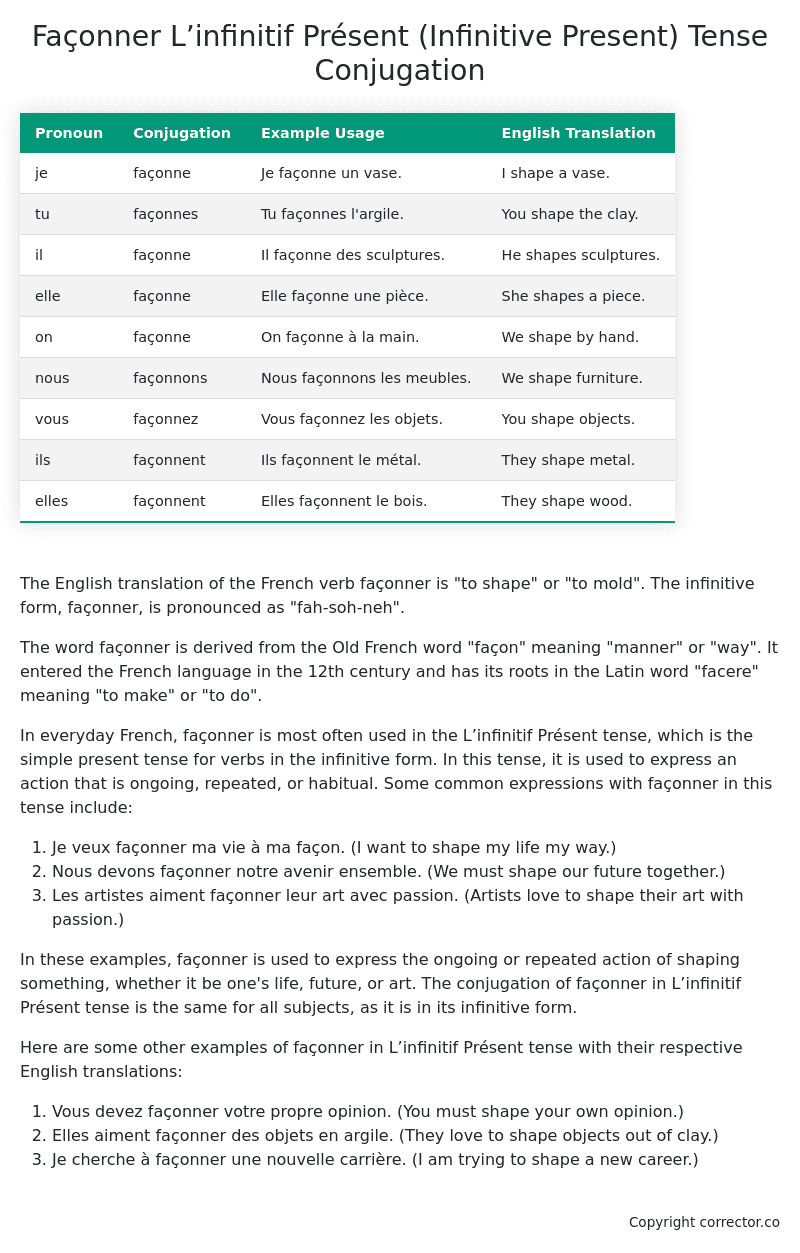L’infinitif Présent (Infinitive Present) Tense Conjugation of the French Verb façonner
Introduction to the verb façonner
The English translation of the French verb façonner is “to shape” or “to mold”. The infinitive form, façonner, is pronounced as “fah-soh-neh”.
The word façonner is derived from the Old French word “façon” meaning “manner” or “way”. It entered the French language in the 12th century and has its roots in the Latin word “facere” meaning “to make” or “to do”.
In everyday French, façonner is most often used in the L’infinitif Présent tense, which is the simple present tense for verbs in the infinitive form. In this tense, it is used to express an action that is ongoing, repeated, or habitual. Some common expressions with façonner in this tense include:
- Je veux façonner ma vie à ma façon. (I want to shape my life my way.)
- Nous devons façonner notre avenir ensemble. (We must shape our future together.)
- Les artistes aiment façonner leur art avec passion. (Artists love to shape their art with passion.)
In these examples, façonner is used to express the ongoing or repeated action of shaping something, whether it be one’s life, future, or art. The conjugation of façonner in L’infinitif Présent tense is the same for all subjects, as it is in its infinitive form.
Here are some other examples of façonner in L’infinitif Présent tense with their respective English translations:
- Vous devez façonner votre propre opinion. (You must shape your own opinion.)
- Elles aiment façonner des objets en argile. (They love to shape objects out of clay.)
- Je cherche à façonner une nouvelle carrière. (I am trying to shape a new career.)
Table of the L’infinitif Présent (Infinitive Present) Tense Conjugation of façonner
| Pronoun | Conjugation | Example Usage | English Translation |
|---|---|---|---|
| je | façonne | Je façonne un vase. | I shape a vase. |
| tu | façonnes | Tu façonnes l’argile. | You shape the clay. |
| il | façonne | Il façonne des sculptures. | He shapes sculptures. |
| elle | façonne | Elle façonne une pièce. | She shapes a piece. |
| on | façonne | On façonne à la main. | We shape by hand. |
| nous | façonnons | Nous façonnons les meubles. | We shape furniture. |
| vous | façonnez | Vous façonnez les objets. | You shape objects. |
| ils | façonnent | Ils façonnent le métal. | They shape metal. |
| elles | façonnent | Elles façonnent le bois. | They shape wood. |
Other Conjugations for Façonner.
Le Present (Present Tense) Conjugation of the French Verb façonner
Imparfait (Imperfect) Tense Conjugation of the French Verb façonner
Passé Simple (Simple Past) Tense Conjugation of the French Verb façonner
Passé Composé (Present Perfect) Tense Conjugation of the French Verb façonner
Futur Simple (Simple Future) Tense Conjugation of the French Verb façonner
Futur Proche (Near Future) Tense Conjugation of the French Verb façonner
Plus-que-parfait (Pluperfect) Tense Conjugation of the French Verb façonner
Passé Antérieur (Past Anterior) Tense Conjugation of the French Verb façonner
Futur Antérieur (Future Anterior) Tense Conjugation of the French Verb façonner
Subjonctif Présent (Subjunctive Present) Tense Conjugation of the French Verb façonner
Subjonctif Passé (Subjunctive Past) Tense Conjugation of the French Verb façonner
Subjonctif Imparfait (Subjunctive Imperfect) Tense Conjugation of the French Verb façonner
Subjonctif Plus-que-parfait (Subjunctive Pluperfect) Tense Conjugation of the French Verb façonner
Conditionnel Présent (Conditional Present) Tense Conjugation of the French Verb façonner
Conditionnel Passé (Conditional Past) Tense Conjugation of the French Verb façonner
L’impératif Présent (Imperative Present) Tense Conjugation of the French Verb façonner
L’infinitif Présent (Infinitive Present) Tense Conjugation of the French Verb façonner (this article)
Struggling with French verbs or the language in general? Why not use our free French Grammar Checker – no registration required!
Get a FREE Download Study Sheet of this Conjugation 🔥
Simply right click the image below, click “save image” and get your free reference for the façonner L’infinitif Présent tense conjugation!

Façonner – About the French L’infinitif Présent (Infinitive Present) Tense
Forming the Infinitive Present
Common Everyday Usage Patterns
As a Verb’s Dictionary Form
After Modal Verbs
As an Imperative
In Infinitive Clauses
Interactions with Other Tenses
Present Tense
Future Tense
Conditional Tense
Passé Composé
Imperfect Tense
Subjunctive and Conditional Moods
Summary
Want More?
I hope you enjoyed this article on the verb façonner. Still in a learning mood? Check out another TOTALLY random French verb conjugation!


